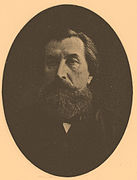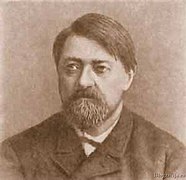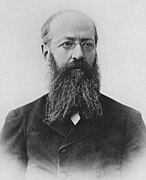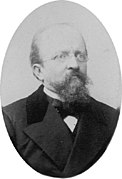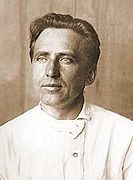Saint Petersburg State University
This article needs additional citations for verification. (January 2024) |
Санкт-Петербургский государственный университет | |
gray[1] | |
| Affiliations | APSIA, BRICS Universities League, Campus Europae |
|---|---|
| Mascot | Boris the Funny Looking Owl[2]
Building details |
Vasilievsky Island is the university's main building and the seat of the administration. | |
| Website | english |
Saint Petersburg State University (SPBU; Russian: Санкт-Петербургский государственный университет) is a public research university in Saint Petersburg, Russia. Founded in 1724 by a decree of Peter the Great, the university from the beginning has had a focus on fundamental research in science, engineering and humanities.
During the
It is made up of 24 specialized faculties (departments) and institutes, the Academic Gymnasium, the Medical College, the College of Physical Culture and Sports, Economics and Technology. The university has two primary campuses: one on
Rankings
| University rankings | |
|---|---|
| Global – Overall | |
| ARWU World[3] | 301-400 (2022) |
| QS World[4] | 315 (2024) |
| THE World[5] | 801-1000 (2023) |
| USNWR Global[6] | 652 (2023) |
| Regional – Overall | |
| QS Emerging Europe and Central Asia[7] | 3 (2022) |
In international rankings, the university was ranked 35th by The Three University Missions Ranking in 2022,[8] 242nd by the QS World University Rankings in 2022,[9] 652nd by U.S. News & World Report in 2023,[6] 601-800th by the Times Higher Education World University Rankings,[5] and 301–400th by the Academic Ranking of World Universities in 2021.[10]
History
1724–1821

It is disputed by the university administration whether Saint Petersburg State University or
Between 1804 and 1819, Saint Petersburg University officially did not exist; the institution founded by Peter the Great, the Saint Petersburg Academy, had been disbanded, because the new 1803 charter of the Academy of Sciences stipulated that there should not be any educational institutions affiliated with it.
The
1821–1917
In 1821, the university was renamed Saint Petersburg Imperial University.
In 1835, a new Charter of the Imperial Universities of Russia was approved. It provided for the establishment of the Faculty of Law, the Faculty of History and Philology, and the Faculties of Physics and Mathematics, which were merged into the Faculty of Philosophy as the 1st and 2nd Departments, respectively.
In 1849, after the


In 1855, Oriental studies were separated from the Faculty of History and Philology, and the fourth faculty, Faculty of Oriental Languages, was formally inaugurated on 27 August 1855.[13]
In 1859–61, female part-time students could attend lectures in the university. In 1861, there were 1,270 full-time and 167 part-time students in the university, of them 498 were in the Faculty of Law, the largest subdivision. But this subdivision had the cameral studies department, where students learnt safety, occupational health and environmental engineering management and science, including chemistry, biology, agronomy along with law and philosophy. Many Russian, Georgian etc. managers, engineers and scientists studied at the Faculty of law therefore. During 1861–62, there was student unrest in the university, and it was temporarily closed twice during the year. The students were denied freedom of assembly and placed under police surveillance, and public lectures were forbidden. Many students were expelled. After the unrest, in 1865 only 524 students remained.
A decree of the Emperor Alexander II of Russia adopted on 18 February 1863, restored the right of the university assembly to elect the rector. It also formed the new faculty of the theory and history of art as part of the faculty of history and philology.[14]
In March 1869, student unrest shook the university again, but on a smaller scale. By 1869, 2,588 students had graduated from the university.
In 1880, the Ministry of National Enlightenment forbade students to marry and married persons could not be admitted. In 1882, another student unrest took place in the university. In 1884, a new Charter of the Imperial Russian Universities was adopted, which granted the right to appoint the rector to the
By 1894, 9,212 students had graduated from the university. Among the scholars of the second half of the 19th century, affiliated with the university were mathematician
As of 1 January 1900 (O.S.), there were 2,099 students enrolled in the Faculty of Law, 1,149 students in the Faculty of Physics and Mathematics, 212 students in the Faculty of Oriental Languages and 171 students in the Faculty of History and Philology. In 1902, the first student
Since about 1897, regular strikes and student unrest shook the university and spread to other institutions of higher education across Russia. During the
In 1914, with the start of the
1918–1939
The Assembly of Petrograd Imperial University openly welcomed the
In 1918, the university was renamed 1st Petrograd State University, and in 1919 the Narkompros merged it with the 2nd PSU (former Psychoneurological Institute) and 3rd PSU (former
In the fall of 1920, as observed by freshman student
In 1924, the university was renamed Leningrad State University after its namesake city. In order to suppress intellectual opposition to Soviet power, a number of historians working in the university, including Sergey Platonov, Yevgeny Tarle, and Boris Grekov, were imprisoned in the so-called Academic Affair of 1929–30 on fabricated charges of participating in a counter-revolutionary conspiracy aimed at overthrowing the government. Some other members of the staff were repressed in 1937–38 during the Great Purge.
1940–1999
During the 1941–44
In 1949–50, several professors died in prison during the investigation of the
In 1966, the Council of Ministers decided to build a suburban campus in
2000–present
Nikolay Kropachev (Кропачев Николай Михайлович), the rector of the Saint Petersburg State University has signed a letter of support for the Russian invasion of Ukraine.[17]
In early 2022, the university expelled 13 students who had protested against the
In response to the Russian invasion, in March 2022 the
Organization
Governance
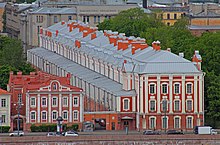
The university is a federal state institution of higher education managed by the
The superior body of self-government of the university is its Assembly, which elects the rector and the Academic Board of the university for a five-year term. The Assembly consists of the members of the Academic Board of the university and the staff delegated by the general assemblies of the main structural subdivisions according to quotas set by the Academic Board of the university. The general administration of the university is vested in the Academic Board, which consists of the rector, who presides over it, as well as the president of the university, vice rectors and representatives of the main structural subdivisions.[citation needed]
Likewise, the general administration of a faculty is vested in its respective academic board elected by the faculty assembly for five years. The procedure of election and department quotas are decided by the faculty-level academic board itself. The dean, who leads the faculty and presides over its academic board, is elected for five years by the faculty academic board.[citation needed]
Academic year
The academic year in St. Petersburg State University according to the Routine Regulations normally starts on 1 September. One lesson normally lasts an hour and a half (two academic hours). The academic year is divided into two semesters. The first semester (term) ends by late December, the second starts in mid-February and lasts until late May. Each term is followed by a series of preliminary tests (in the last week of December/May) and exams (in January/June).[citation needed]
Campuses

The university has two main campuses: on Vasilievsky Island in the historic city center and in Peterhof (formerly Petrodvorets), a southwestern suburb, which can be reached by railway from the city's
The new suburban campus consists of the Faculty of Applied Mathematics and Control Processes, Institute of Chemistry, Faculty of Mathematics and Mechanics, and Faculty of Physics, which are in modern buildings in Peterhof. Nearby the Peterhof campus there is a park area called Sergievka. In the Sergievka park there are buildings of the Faculty of Biology.[citation needed]
Faculties and Institutes
SPbSU is made up of 24 specialized faculties, which are:
- Faculty of Applied Mathematics and Control Processes (*rus | *eng)
- Faculty of Biology (*rus)
- Institute of Chemistry
- Faculty of Medical Technology (*rus)
- Faculty of Economics (*rus)
- Institute of Earth Sciences (*rus)
- Institute of History (*rus)
- School of International Relations (*rus)
- Faculty of Law
- Faculty of Liberal Arts and Sciences (*rus | *eng)
- Faculty of Mathematics and Mechanics (*rus | *eng)
- Faculty of Medicine (*rus)
- Faculty of Oriental Studies (*rus | *eng)
- )
- Faculty of Philology (*rus | *eng)
- Institute of Philosophy (*rus | *eng)
- Faculty of Physics (*rus | *eng)
- )
- Faculty of Psychology (*rus | *eng)
- Faculty of Sociology (*rus)
- Graduate School of Management
- Military Faculty (*rus)
- School of Journalism and Mass Communications (*rus | *eng)
- Faculty of Applied Communications
- Faculty of Journalism
- Faculty of
There is also a Department of Physical Culture and Sports. (*rus)
Notable alumni and faculty


Russian revolutionary and founder of the
Nine graduates of the university are
Among the scholars affiliated with St-Petersburg State University have been
The American novelist Ayn Rand attended the university from 1920 to 1924, graduating with honors in history.[27] Ukrainian nationalist and publicist Dmytro Dontsov studied law at the university for some time after 1900.
Rectors
- 1819–1821 Mikhail Balugyansky
- 1821–1825 Yevdokim Zyablovskiy (acting)
- 1825–1836 Antoine Jeudy Dugour
- 1836–1840 Ivan Shulgin
- 1840–1861 Pyotr Pletnyov
- 1861 Izmail Sreznevsky (acting)
- 1861–1863 Aleksandr Voskresensky (acting)
- 1863–1865 Heinrich Lenz
- 1865–1867 Aleksandr Voskresensky
- 1867–1873 Karl Kessler
- 1873–1876 Pyotr Redkin
- 1876–1883 Andrey Beketov
- 1883 (1884)–1887 Ivan Andreevsky
- 1887–1890 Mikhail Vladislavlev
- 1890 Ivan Pomyalovsky (acting)
- 1890–1897 Pyotr Nikitin
- 1897–1899 Vasily Sergeevich
- 1899–1903 Adolf Holmsten
- 1903–1905 Aleksandr Zhdanov
- 1905–1910 Ivan Borgman
- 1910–1911 David Grimm
- 1911–1918 Erwin Grimm
- 1918–1919 Alexander Ivanov
- 1919 Sergei Zhebelev (acting)
- 1919–1922 Vladimir Shimkevich
- 1922–1926 Nikolay Derzhavin
- 1926–1927 Vsevolod Tomashevsky
- 1927–1930 Mikhail Serebryakov
- 1930–1932 Yury Nikich-Krilichevsky (director)
- 1932–1933 Viktor Seryozhnikov (director)
- 1933–1937 Mikhail Lazurkin (director)
- 1937-1938 Boris Berezin (acting)
- 1938–1939 Konstantin Lukashev (director)
- 1939 Artemy Marchenko (acting)
- 1939–1941 Pyotr Zolotukhin (director)
- 1941–1948 Alexander Voznesensky
- 1948–1950 Nikita Domnin
- 1950 Mikhail Artamonov (acting)
- 1950–1952 Alexey Ilyushin
- 1952–1964 Aleksandr Aleksandrov
- 1964–1970 Kirill Y. Kondratyev
- 1970–1975 Gleb Makarov
- 1975–1986 Valentin Aleskovsky
- 1986–1993 Stanislav Merkuriev
- 1993(1994)–2008 Lyudmila Verbitskaya
- since 2008 Nikolai Kropachev
-
Heinrich Lenz
-
Aleksandr Aleksandrov
See also
- Education in Russia
- List of universities in Russia
- Open access in Russia
- Smolny College
- List of early modern universities in Europe
References
- ^ "Фирменные цвета" [Signature colors] (in Russian). spbu.ru. Retrieved 28 March 2017.
- ^ "We have athletes who make us proud: Mikhail Konjaria on the end of the University sports season". spbu.ru. Archived from the original on 13 October 2020. Retrieved 11 October 2020.
- ^ "ARWU World University Rankings 2022 - Academic Ranking of World Universities 2022 - Top 500 universities - Shanghai Ranking - 2022". shanghairanking.com. Archived from the original on 19 January 2019. Retrieved 5 November 2017.
- ^ "Saint Petersburg State University | Top Universities". Topuniversities.com. 16 July 2015.
- ^ a b "Saint Petersburg State University Global, Subject & Regional Rankings". Gotouniversity.com.
- ^ a b "Best Global Universities in Russia". US News. Retrieved 19 April 2023.
- ^ "QS World University Rankings-Emerging Europe & Central Asia". Retrieved 15 January 2023.
- ^ "Moscow International University Ranking, 2022". MosIUR "The Three University Missions".
- ^ "Saint Petersburg State University". roundranking.com.
- ^ "Saint Petersburg State University". Archived from the original on 18 November 2011. Retrieved 9 October 2011.
- ^ ISBN 978-3642282195.
- ^ Rudakov, Vasiliy. Brockhaus and Efron Encyclopedic Dictionary. p. 787, Volume VIIIa.
- ISBN 978-0203832752.
- ISBN 978-9004204751.
- ^ Rostovcev, E.A. (2006). The Capital University in a Time of War. Stuttgart: Franz Steiner Verlag. pp. 177–188.
{{cite book}}:|work=ignored (help) - ISBN 0-385-19171-5.
- ^ "Обращение Российского Союза ректоров 04.03.2022". Российский Союз Ректоров. 4 March 2022. Archived from the original on 7 March 2022.
- ^ "Russia's Oldest University to Expel Students Detained at Anti-War Protests – Kommersant". The Moscow Times. 9 March 2022.
- ^ "The war in Ukraine ruins Russia's academic ties with the West". Business Standard India. 3 April 2022 – via Business Standard.
- ^ Heisey, Talia (28 February 2022). "Middlebury College suspends its Russia study abroad program, urges students to leave the country". VTDigger.
- ^ "University of Bremen Reduces Ties to Russia to a Minimum | Bremen Study Abroad Program". Blogs.dickinson.edu. 3 March 2022.
- ^ "CEMS suspends the institutional partnership with the Graduate School of Management in St Petersburg". Cems.org.
- ^ "Solidarity with Ukraine / Tolerance on our international campus" (PDF). Haw-hamburg.de. Retrieved 25 July 2022.
- ^ "St. Petersburg State University suspended from Coimbra Group". Coimbra-group.eu.
- ^ "European University Association suspends Russian members over pro-war statement". Sciencebusiness.net.
- ^ "US Colleges End Academic Ties with Russia over Ukraine War". Thecollegepost.com. 4 March 2022.
- ^ Branden, Barbara (1986); p. 54.
- ^ "Реальная история великого комбинатора" [The real story of the great combinator] (in Russian).
Bibliography
- Lempert, David (1996). Daily Life in a Crumbling Empire: The Absorption of Russia into the World Economy. Eastern European Monograph Series. Vol. 2. Columbia University Press. ISBN 978-0-88033-341-2. - The history of the university, with a particular focus on the law faculty, from the 19th century to the perestroika period











